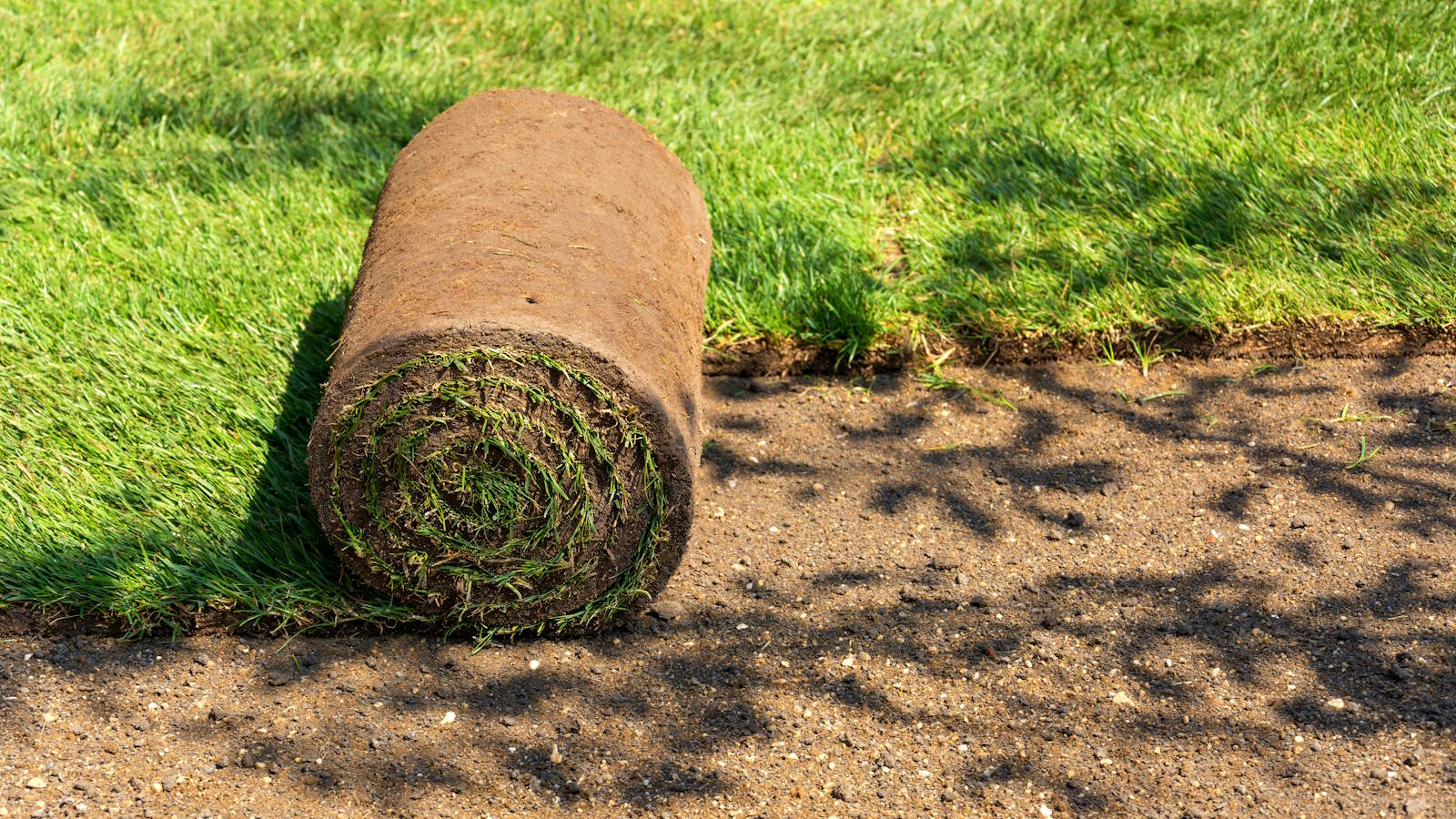How to lay turf in 7 steps – as recommended by lawn specialists
The importance of preparation, technique, and aftercare should not be underestimated if you want a beautiful lawn


Laying turf is a quick and attractive way to get a new lawn. Rolls of turf are inexpensive and it offers a much faster alternative to sowing a new lawn using grass seed. You can lay the turf yourself rather than using a contractor, but how difficult is it to lay turf?
Knowing how and when to lay turf is important. It may seem simple enough to roll out the turf to get an instant lawn - however, there are many ways things can go wrong and you can end up with a brown and patchy yard rather than the thick and green lawn you envisaged.
To help you avoid making a lawn care mistake that you will rue, we hear from some highly experienced professionals to get advice for preparing the ground, laying the turf, and looking after freshly laid turf - all to help you get a beautiful lawn.

Laying turf can deliver great results quickly
Laying turf vs sowing a new lawn
While grass seed is inexpensive, it can take up to six months to get a lawn strong enough to cope with the wear and tear of a family household. Turf makes a faster impact as the wait to use the lawn can drop from six months to one month.
Add to that the fact that turf gives that immediate look and it is understandable why many homeowners choose to lay turf, rather than planting grass seed, when they want a new lawn.
How to prepare the ground

Any existing grass must be removed prior to laying turf
Preparing the ground is essential to ensuring any new lawn is established quickly and successfully.
Any old grass, for example, if you are replacing an existing lawn, needs to be removed - this can either be done by hand with a spade, or a sod lifter available at Amazon, for small lawns or with a mechanical turf cutter, that can commonly be rented from hardware stores.
Design expertise in your inbox – from inspiring decorating ideas and beautiful celebrity homes to practical gardening advice and shopping round-ups.
Mathew Koch from Scotts Miracle-Gro says that removing the grass is essential, adding: ‘Never lay new sod directly on top of existing turf, since doing so will kill both the new and existing grass.’
Weeds, including tricky perennial lawn weeds such as bindweed and couch grass, must be removed, ideally by hand to remove the roots completely. Any other debris, including large rocks, should also be removed so you have clean soil to work with.
The soil wants to be tilled to a depth of 4-6 inches and have a lot of organic matter, like compost or well-rotted manure, incorporated for improved fertility. The addition of a starter fertilizer before laying the turf can provide essential nutrients that will help early development.
Amendments, such as adding compost, will not only help the fertility but also help sandy soils hold more moisture. If you have clay-like or claggy soil, however, Chrissie Handley, a lawn care specialist working for Online Turf advises: ‘You will want to mix in some good quality topsoil to create a new, more suitable mixture’.
Once the soil has been cleared, tilled, and amendments added, the next step is to rake it level and break up any clumps of soil. The soil wants to be loose to allow the roots to penetrate easily. After raking, light tread the soil in different directions before raking again to create a level bed.

Matthew Koch joined Scotts Miracle-Gro in 2012 after finishing his PhD work in plant genetics and breeding at Rutgers University. He began as a Scientist in the Biotechnology program and has held several leadership roles since. He is currently the director of biotechnology, genetics, and seed where he oversees the R&D activities of these teams.
How to lay the turf

Rolls must not dry out when laying turf
To help you lay grass sod successfully, we look in-depth at 7 key areas to get right:
- Start on an edge to establish a good starting line and work across the area. Mathew Koch recommends to ‘unroll the first roll of sod against the longest edge of the area’. If you are laying your turf on a slope, he advises: ‘Be sure to lay it in a horizontal pattern across the slope to better promote water retention.’
- Once you have the first roll laid you then work along the lawn, laying rolls next to each other as close as possible. Taylor Olberding, from Heroes Lawn Care, says to lay ‘in a staggered pattern’ in the same manner as a brick wall. ‘Press edges firmly together while avoiding stretching or overlapping, ensuring good soil contact for root establishment,’ advises Taylor.
- Check that each roll of turf is level as you go - a wooden board and spirit level, available at Walmart, are recommended to get an accurate level - and you can use a mix of topsoil and sand to level the lawn if required.
- The ends of the turf can be trimmed to fit the boundaries of the space or cut if you need to shape the lawn around trees, beds, or borders. A sharp knife or half-moon lawn edging tool is an essential garden tool for this task.
- You can help to establish good contact between the soil and the newly laid turf by tamping down the turf. The back of a garden rake is the simplest way to do this. Only work off boards when laying or tamping down the turf, as Mathew Koch says: ‘It’s best to avoid stepping directly on the newly laid sod, which can cause the sod to shift and increase the potential for gaps in the lawn.’
- Once the turf has been laid, fill the seams between the rolls with a mixture of topsoil and fast-growing grass seed. This top-dressing will fill any gaps and help to ensure a total coverage of grass.
- Water the turf immediately after putting it in place. If there is no rain forecast then a lawn sprinkler may be required, The soil wants to be kept consistently moist for the first few weeks for the roots to establish and develop.
Caring for newly laid turf

Sufficient watering is key after laying any turf
Watering is a vital task in the early weeks of laying turf so that the new lawn successfully roots. Chrissie Handley recommends that it may require frequent waterings for between 2-4 weeks to begin with.
She says: ‘If laying in hotter temperatures, the turf will need watering in the morning and in the evening when the sun is not directly overhead. In periods of heavy rainfall, you will not need to water as much. After a few weeks, the plant will root into the ground a knit together, giving you a fully formed lawn.’
It is important to water the lawn deeply. The soil underneath the turf wants to be moist so the roots penetrate down into the ground. Shallow watering will encourage shallow rooting that leaves the lawn more susceptible to drought and unable to stand up to lots of footfall and usage. Avoid watering the lawn at night as this can leave it more susceptible to fungal diseases, it is best to water grass in the morning to allow it all day to dry.
Avoid heavy usage of the lawn for at least the first month after laying the turf. You do not want to walk on or mow the turf until it has rooted firmly, which could take 3-4 weeks from being laid. When the roots prevent you from lifting the turf at the edges it is a sign that the turf has strongly established.
Wait to fertilize a new lawn at least 4-6 weeks after you laid the turf. It is best to feed with a starter fertilizer at this stage and then wait another six weeks before considering using normal lawn feeds.

Chrissie Handley is Lawn Care Specialist providing tailored advice on laying, maintenance and general lawn care for Online Turf.
FAQs
Do you wet topsoil before laying turf?
If you are laying the turf during the hotter summer months, it will be beneficial to water the soil to help the turf establish. The soil wants to be moist ahead of laying turf, but not too soggy.
What not to do when laying turf?
A few key aspects of what not to do include letting the turf dry out, overlapping the turf when laying it, walking directly on the new lawn too much, and using heavy equipment on freshly laid turf.
Why is my newly laid turf turning brown?
The prime reason newly laid turf turns brown is that it has not been watered enough. Another tell-tale sign of a lack of watering is the edges of the turf drying out.
When a new lawn is established, a regular lawn care maintenance regime will keep it healthy and looking fantastic. Along with mowing, aerating a lawn, dethatching, and fertilizing a lawn annually are important steps to having a beautiful lawn year after year.

Drew has worked as a writer since 2008 and was also a professional gardener for many years. As a trained horticulturist, he worked in prestigious historic gardens, including Hanbury Hall and the world-famous Hidcote Manor Garden. He also spent time as a specialist kitchen gardener at Soho Farmhouse and Netherby Hall, where he grew vegetables, fruit, herbs, and cut flowers for restaurants. Drew has written for numerous print and online publications and is an allotment holder and garden blogger. He is shortlisted for the Digital Gardening Writer of the Year at the 2025 Garden Media Guild Awards.

